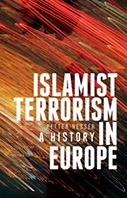Islamist Terrorism In Europe: A History

Author: Peter Nesser
Publisher: New York: Oxford University Press, 2015. 371p.
Reviewer: David Schultz | March 2017
Islamic terrorism and terrorist attacks are a reality across Europe now. Detecting, preventing, or containing them is a major objective of the European Union (EU) and of individual countries. Yet in combating this terrorism, one needs to understand who the terrorists are and the strategies they employ. This is the subject of this book.
Arguably the most important message here is that Islamist terrorism in Europe is not monolithic. There is not one type of Islamist terrorist; and the various groups and strategies are not being centrally directed from above by one leader or group. Nesser opens his book by constructing a typology that seeks to answer several questions: What are the main parts involved in the emergence of jihadi cells in Europe? Who are the terrorists? How do they radicalize? How are cells connected to one another and internally organized, and what factors determine the whens, whys, and hows of attacks.
Consistently, attacks involve cooperation between terrorist cells and networks within specific countries, as well as with those operating internationally. They are often initiated by radical preachers or other extremist leaders, where they generally meet in mosques, prisons, schools, or NGOs. Motivations for the attacks vary, with some being sourced in local issues in specific European countries, such as the French banning of head scarfs, or the Charlie Hebdo cartoons. In some cases, international events, such as the invasion of Iraq or Afghanistan, encouraged attacks, especially against countries that supported these causes. Increasingly, the attacks have been aimed at public infrastructures or facilities, but again in some cases specific targets were chosen because they were seen as having insulted Islam in some way.
The most fascinating part of the first chapter of the book is describing who the terrorists are and the conditions under which they radicalize. Nesser distinguishes among entrepreneurs, proteges, misfits, and drifters. The entrepreneurs are the leaders and for most of the organized terrorism they are the ones who help direct the attacks. They are activists with a strong sense of injustice having been committed against Islam, and are seeking revenge. They recruit and train other cell members. Proteges are second-in-command, and are given tasks to perform and are often nurtured by the teachings of the entrepreneurs. Misfits are loners, radicalized because of personal troubles such as poverty or social maladjustment. Finally, the drifters, who may be the majority of terrorists, join because of social ties to those already in cells. Distinguishing among these four types of terrorists is important because detecting and combating the entrepreneurs is critical to preventing organized cells and plots from developing and radicalizing others. Finding and deterring the misfits is, however, especially difficult. There is no one motivation and reason for why one becomes a terrorist, and therefore developing multiple strategies for fighting them is important.
The bulk of the book explicates the typology constructed in the first chapter. The author discusses the rise of various terrorist groups and grievances arising out of Algeria, post 9/11, the Iraq invasion, Pakistan, in northern Europe, and then the rise of ISIS and the Syrian Civil War. Each of the chapters describes the specific forces that motivated terrorist groups arising out of these conflicts or incidents, indicating both common features that all of the Islamic terrorists’ plots and groups had, as well as the nuances they developed in response to unique circumstances and grievances.
The conclusion of the book is a sobering one – namely that Islamic terrorism has become more decentralized and complex. There is no central leadership, especially after the death of Osama Bin Laden, and it is harder to track and detect plots and attacks. Multiple tactics are needed to combat these groups; and it does not look as if there is a single or simple way to win the war on this form of terrorism in the near future.
Anyone seeking to understand Islamic terrorism in Europe, and the law enforcement problems it presents needs to read this book.
David Schultz, Professor, Department of Political Science, Hamline University


